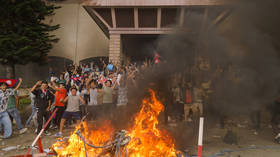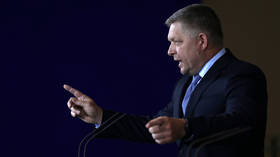Big Mac attack: US low-wage workers prepare to strike in over 200 cities
Low-wage fast food workers are preparing for a one-day nationwide protest in what some are saying will be the largest mobilization of US workers seeking to achieve higher pay, benefits and the right to unionize.
Fast food employees are planning a labor walkout in some of the largest American cities, including Detroit, Los Angeles, New York, St. Louis and Kansas City, as part of the Fight for $15 movement.
However, other low-wage groups will also be joining the fast food employees, including Walmart workers, home-care assistants and childcare workers in what organizers say will be the biggest demonstration by low-wage workers in American history.
READ MORE: McDonald’s raises pay, improves benefits for 90,000 employees
International protesters, in solidarity with their US counterparts, will organize demonstrations in more than 100 cities in 35 countries, according to the organizers. Among the various planned actions include a one-day strike by fast food workers in New Zealand and by restaurant, hotel and tourism employees in Italy.
Organizers chose April 15 - the day US tax returns are due - to draw attention to their demand, and to illustrate how many low-wage workers are now dependent on government handouts.
More than 52 percent of fast-food employees depend on public assistance to make ends meet, according to a recent report by the UC Berkeley Labor Center.
Tokyo says raise the wage!! in solidarity with all fast food workers in the world"@ChieMatsumoto: 【#FastFoodGlobal】 pic.twitter.com/gv4yAnsT0s"
— 内田聖子 (@uchidashoko) April 15, 2015
The US government currently spends $150 billion annually to sponsor welfare programs, such as Medicaid and the Supplemental Nutrition Assistance Program (SNAP), which serves as a food safety net for millions of eligible, low-income individuals and families. Critics say the government would not have to spend so much money if corporations paid a fair living wage.
The Berkeley report revealed that the real hourly wage of an
average US worker was just 5 percent higher in 2013 compared to
1979, while the wages of the bottom 10 percentile have plunged to
5 percent lower in 2013 than in 1979.
Sylvia Allegretto, an economist at the Institute for Research on
Labor and Employment at the University of California, Berkeley,
said the movement is an extension of the pain that is still being
felt by lower-wage workers following the Great Recession that
began in 2008.
READ MORE: McDonald's enters world of kitsch with Big Mac wallpaper, bed sheets
“Low-wage workers really paid the price for the Great Recession brought to you by the wizards of Wall Street who are now booming,” Allegretto told McClatchy News. “CEO pay is back to being hundreds of times more than what the typical worker makes. Corporate profits are doing very well. And these workers are saying ‘Wait a minute. What about us?’ ”
Wednesday’s labor movement comes just weeks after McDonald's said it was boosting salaries for a tiny portion of its workforce by $1. However, many workers have called the decision a “PR stunt” and an effort to keep a lid on dissent in the ranks. McDonald’s told the Wall Street Journal the protests were not a factor in their decision.
McDonald's workers protesting zero hour contracts outside the fast food giants Linwood restaurant in Christchurch pic.twitter.com/miDZY0Twbu
— RadioLIVE Newsroom (@LIVENewsDesk) April 15, 2015
McDonald’s announced in early April it will increase wages by $1 over the legal minimum wage, to an average of $9.90 an hour by July 1, with an additional increase to more than $10 by 2016.
“We’ve been working on a comprehensive benefits package for our employees – the people who bring our brand to life for customers every day in our US restaurants,” said McDonald’s President and CEO Steve Easterbrook in a statement.
The pay increase, however, is mandatory for just 10 percent of its employees. As for the remainder of the 660,000 employees working at more than 14,000 independently owned McDonald’s restaurants, McDonald’s said franchise owners are free to make their own decisions about pay and benefits.
Currently, the US minimum wage is $7.25 an hour, a rate that hasn’t increased since 2009 despite appeals to Congress by President Obama. Lawmakers in 29 states, however, have responded to public outcry and boosted their minimum wage above the federal level.
The intensifying movement to increase the wages of non-unionized
employees began in November 2012, when hundreds of fast food
workers in New York City walked off the job in protest, demanding
$15 hourly wages and the right to unionize.
Since then, the Service Employees International Union has
provided financial backing for the “Fight for $15” movement,
which has moved beyond fast food to incorporate other sectors of
employment, including retail employees and child care workers.













